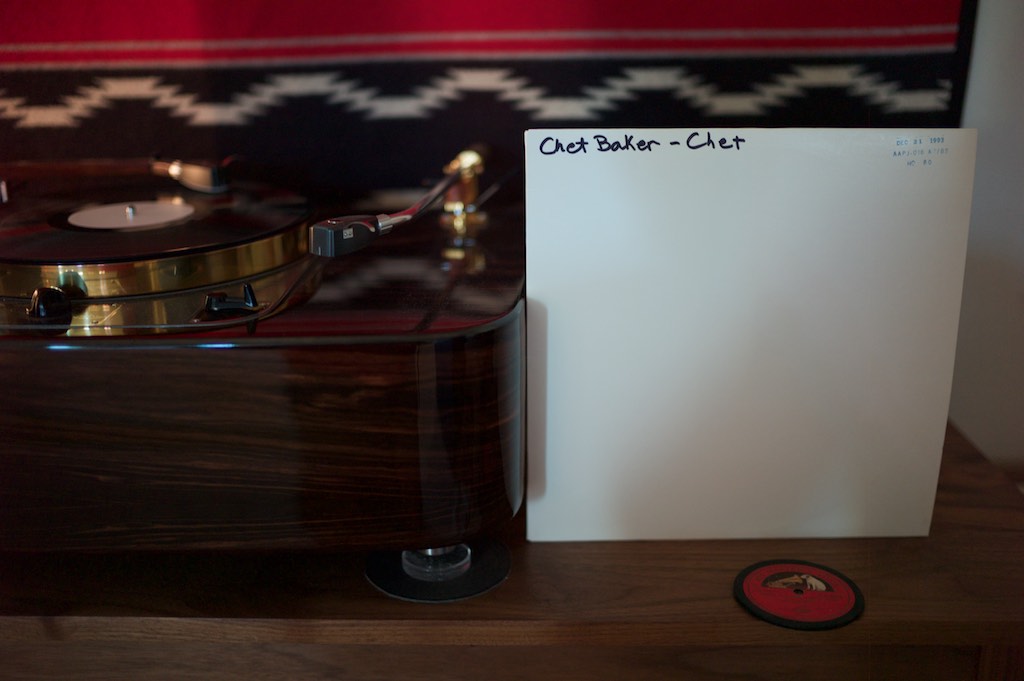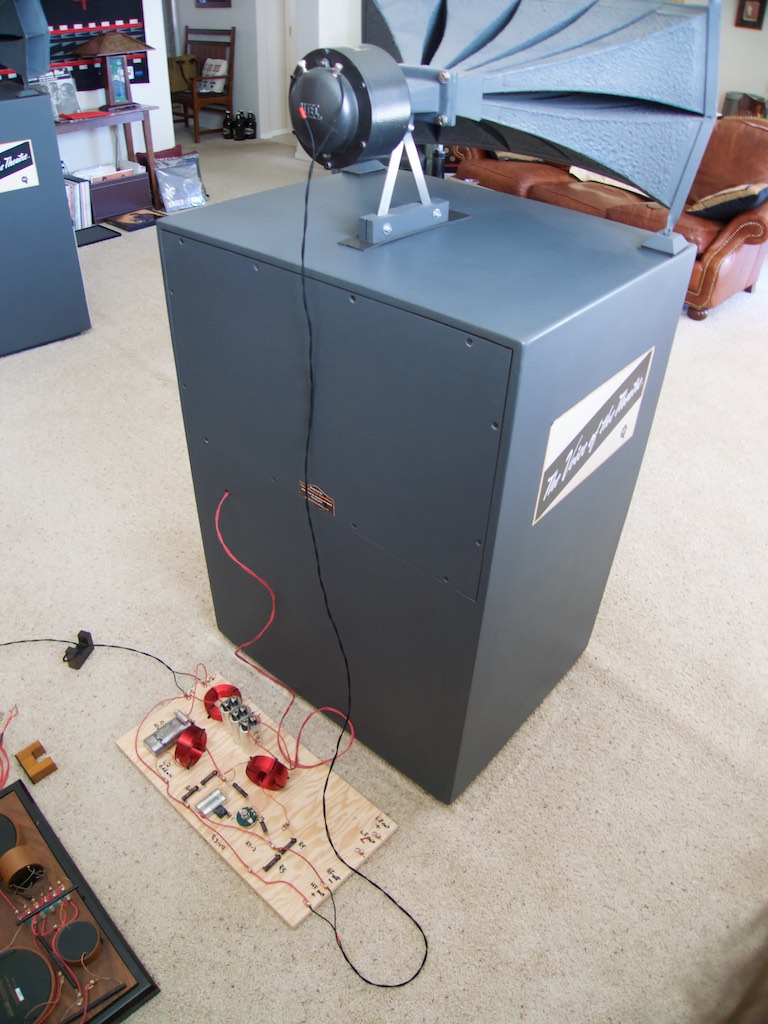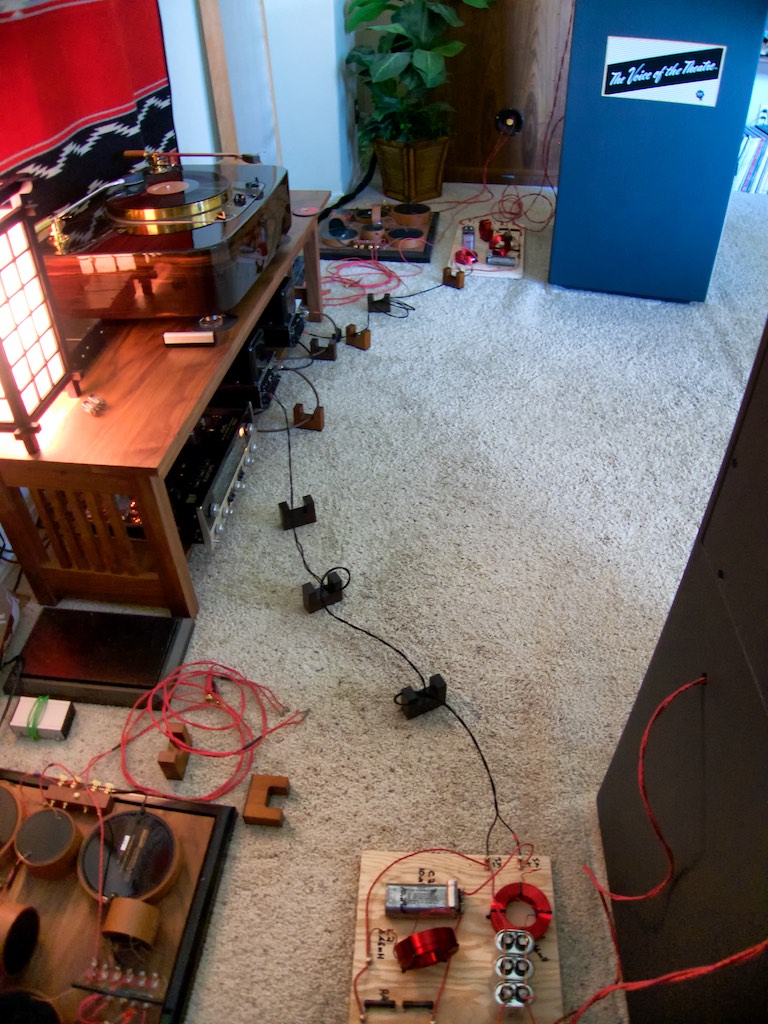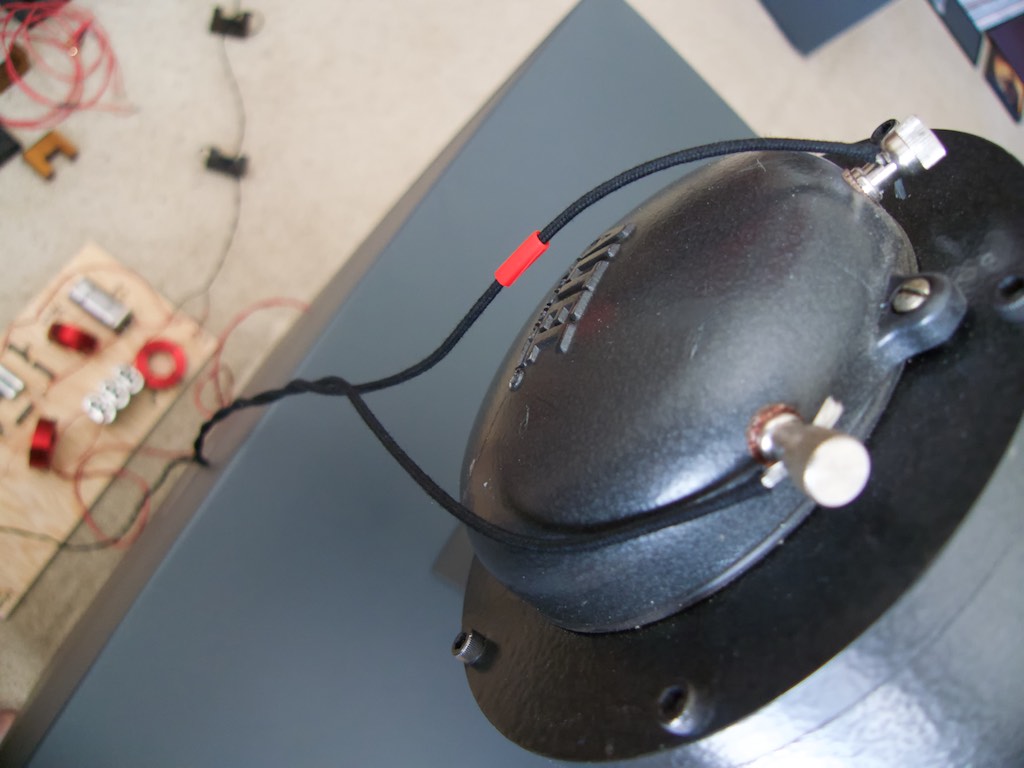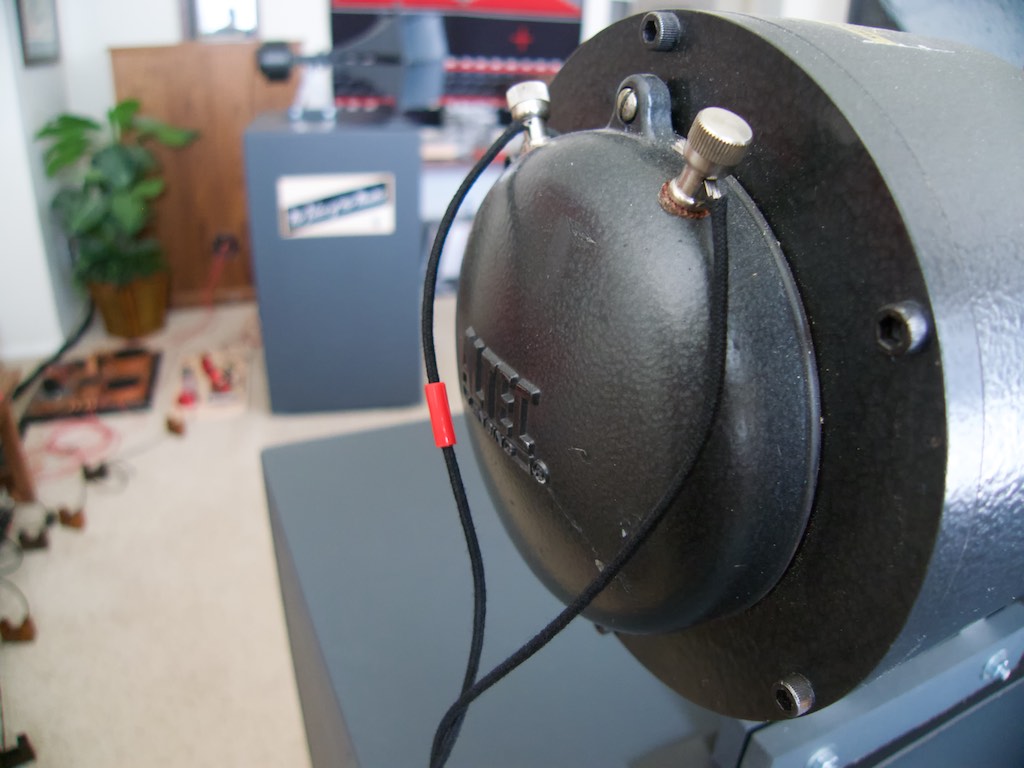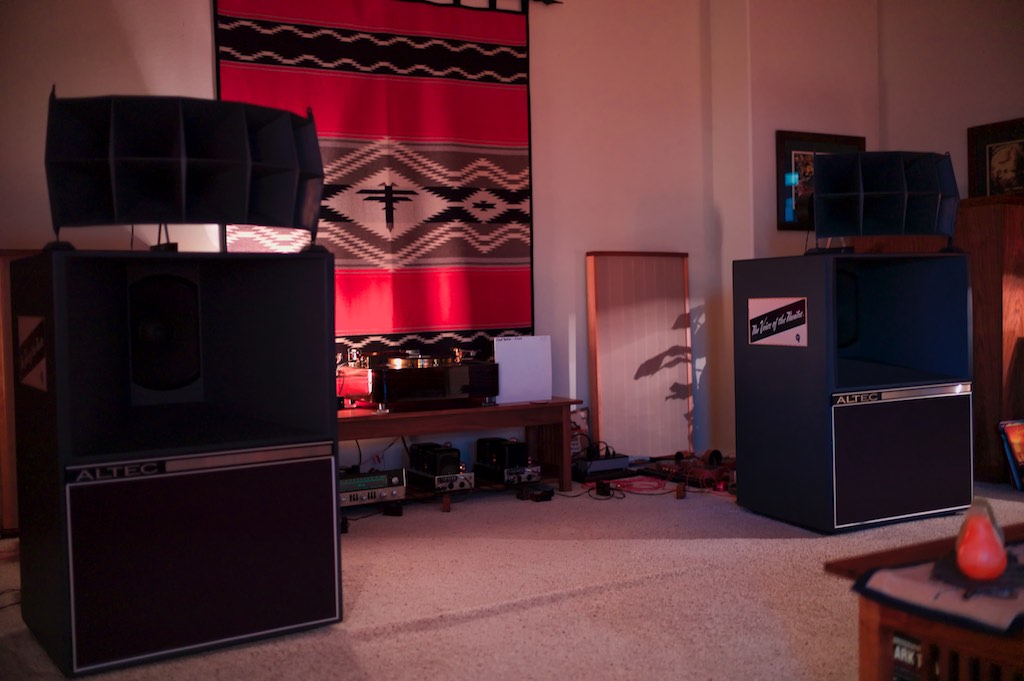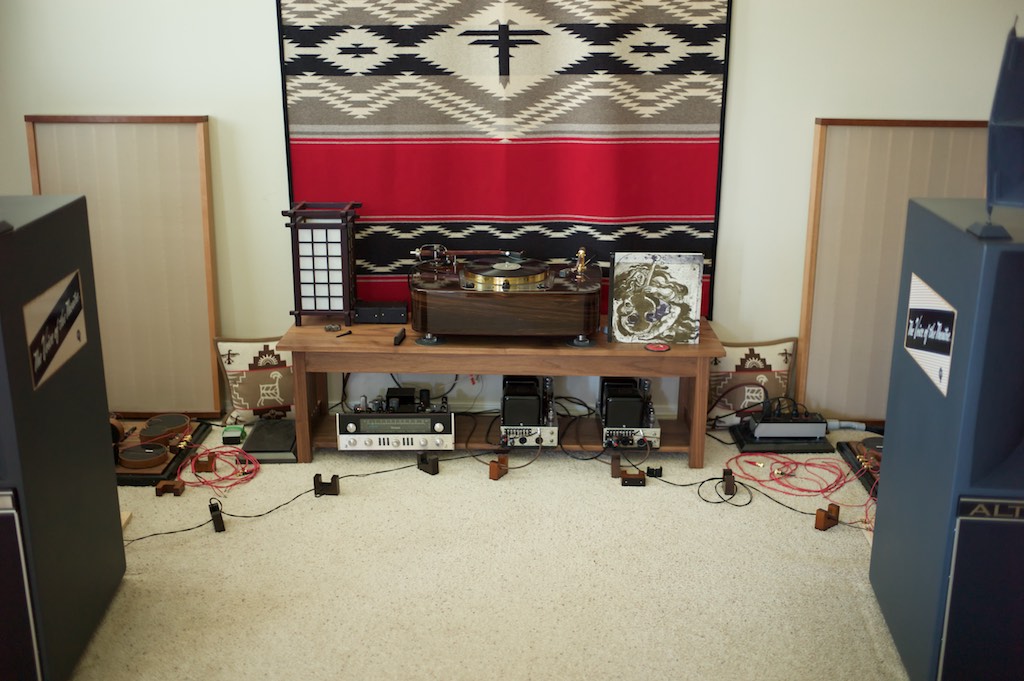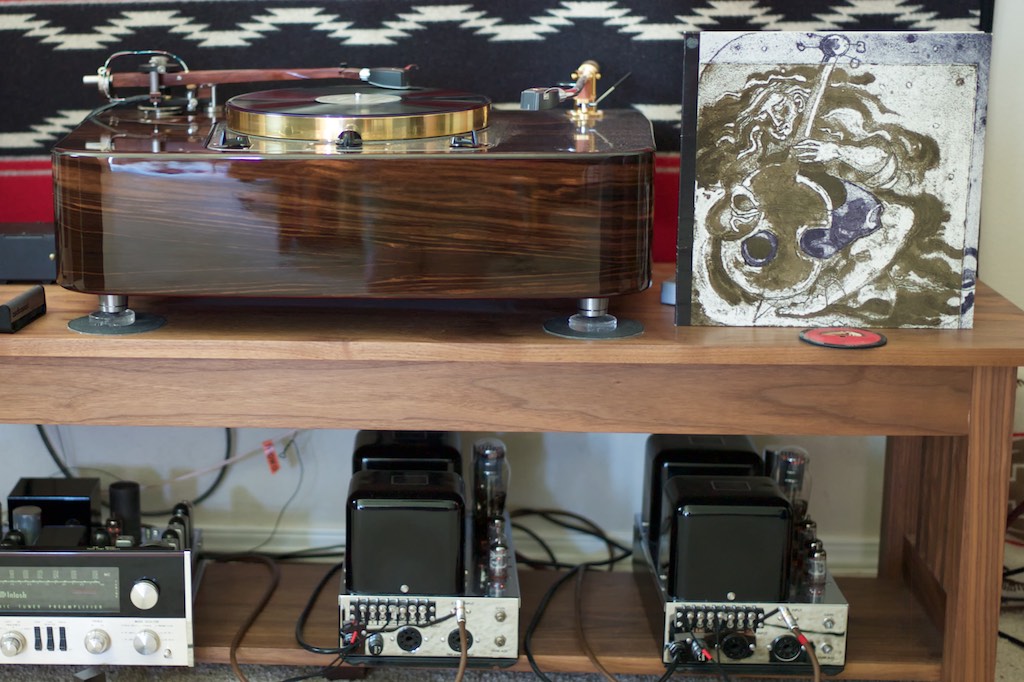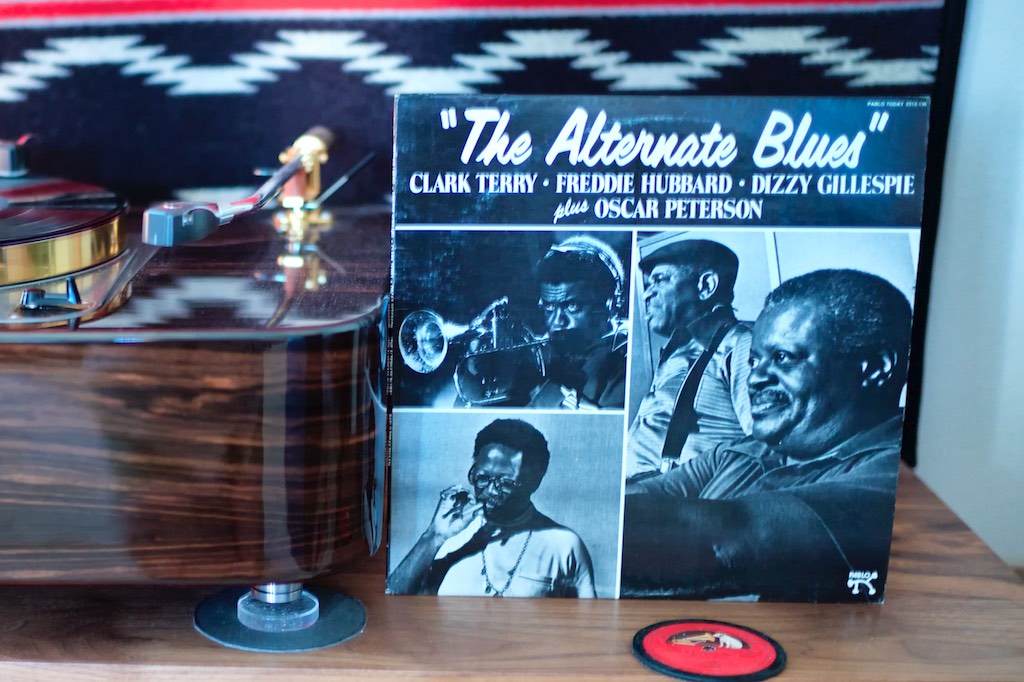It's been really busy lately for yours truly, but tonight I'm relaxing for a little bit, and listening to a little jazz over my vintage Altec A5 Voice of the Theatre loudspeakers project, which at the moment is playing my Analogue Productions test pressing of Chet Baker's Chet.
I probably shouldn't say this, as it drives prices up, but the Analogue Productions test pressings are ridiculously good, and I absolutely love the one I have of Chet Baker's Chet. Chet makes a great reference for how well the system is performing, featuring greats Chet Baker on trumpet, Herbie Mann on flute, Pepper Adams on sax, Bill Evans on piano, Kenny Burrell on guitar, Paul Chambers on bass, and either Connie Kay or Philly Joe Jones on drums, depending on the track. A jazz all-star lineup if there ever was one!
The A5 VOTT crossover project is going well, and I'm getting to a place where I'm thinking I could call it 'good' and start thinking about doing some nice enclosures, and wrapping the crossover project up. When I get everything finished up with the A5 VOTT's I'm planning on writing it up as a feature article for Positive Feedback, and I'll be including my Stokowski A7 VOTTs in my Voice of the Theatre time-travel article as well.
The Altec A5 Voice of the Theatre loudspeakers (as well as the A7 VOTTs), with a Hiraga-san inspired crossover, are super speakers at relatively affordable prices, and ones that I can easily recommend to you for consideration as your last loudspeaker system ever - they're that satisfying.
All those things you've heard about vintage Altec Voice of the Theatre loudspeakers are true, they're magical music machines when you get them dialed in properly.
I'm finding that there's very good reasons why Altec A7's and A5's are so revered among the cognoscenti!
I've already commented on the Duelund DCA16GA wire used as speaker cables from my vintage McIntosh MC30 monaural amplifiers to the Hiraga-san inspired breadboard crossovers for my Altec A5 VOTTs in a previous post, so I won't repeat that other than to say the DCA16GA is working great, and has exceeded my expectations both musically & sonically in every way.
At the close of that previous post I mentioned that I had put the Duelund DCA16GA in the system from the breadboard crossovers to the Altec 288C Alnico high-frequency compression drivers and Altec 1005B 10-cell horns combination (I'm still using Western Electric WE16GA in the crossovers and from the crossovers to the bass drivers - one step at a time!).
Unlike the DCA16GA used as speaker cables (warm & rich right off the bat), the DCA16GA from the breadboard crossovers to the Altec 288C & 1005B combo behaved just like the Western Electric WE16GA, in that it sounded a little rough at first, the way tinned-copper conductors usually do, before settling down into that familiar Western Electric WE16GA-like musical wonderfulness.
I don't know why there would be a difference with the initial sound of the DCA16GA used in those two locations, but that's the way it played out, although as things settled-in they ended up in at that familiar musical territory that I have come to expect from tinned copper conductors, as used in the Western Electric WE16GA, and now the Duelund DCA16GA.
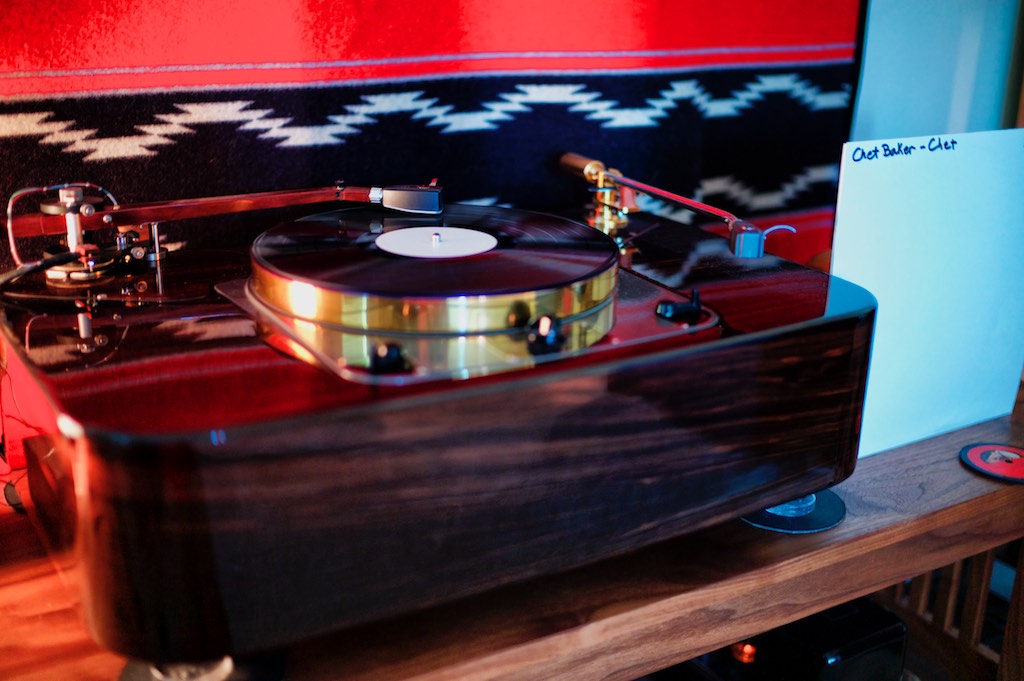
Chet Baker's 'Chet' test pressing being played back by the formidable Woody SPU tonearm (left, review underway).
I'm on a real jazz trumpet kick lately, and I absolutely love the way Chet played trumpet. I think Chet was playing a 1940'ish Martin Committee trumpet with Bach 6C mouthpiece, but I'm not certain (if you know for sure, let me know!). In any event, Chet's trumpet playing is absolutely ravishing on Chet and the Duelund DC16GA lets it come through in spades.
I've noticed that one of the ways the Duelund DCA16GA excels is with overtones, even more so than the WE16GA, which makes the music sound rich and colorful, with a Kodachrome-like vivid intensity, and I've found it to make music really mesmerizing to listen to. Or as Yazaki-san likes to say, "real sound", or maybe I should say "real music".
I've actually found it rather difficult to be 'analytical' to characterize what I'm hearing the Duelund DCA16GA do on Chet because it sounds so bloody musical and emotionally engaging. Whether it's Chet's trumpet, Herbie's flute, Pepper's sax, Bill's piano, Kenny's guitar, or Paul's bass, etc., the tone is just out of this world.
I was going to put on another couple of LPs and tell you about what I'm hearing from the DCA16GA (there's a lot more to tell), but I'm running out of steam after a long day, so I'll continue with my listening impressions of the Duelund DCA16GA in future posts, and I'm just going to kick back now and listen to a little music for the pure enjoyment of it!
For now, let's just sum it as "the Duelund DCA16GA is sounding great!"
Update Saturday, July 30th:
When I read Juste Wotan's comment on my earlier introductory blog post to the Duelund Coherent Audio DCA16GA wire, I realized not everyone has been reading along on the developing story of the tinned-copper conductors' 'vintage tone' discussion here at Jeff's Place over the last year or so.
So here's a little bit of an intro for you about why I think the Duelund DCA16GA wire is such an important development:
In thinking back over my hi-fi life, I’ve used a lot of different kinds of wire in various hi-fi applications over the years, such as speaker cables, RCA interconnects, power cords, tonearm wires, headshell wires, USB interconnects, internal electronics wiring, internal speaker wiring, crossover wiring, and no doubt things I'm forgetting to mention, both as commercial and DIY projects.
I've tried copper, fancy copper, silver-plated copper, pure silver, and even gold as conductors, and they all have their merits. I've also tried cables with many types of dielectrics, from basic cotton to fancy multi-layer screened cables, some even included fancy little black boxes with quantum filters, and they too all have their merits. I've tried a lot of different terminations too, with the exception of balanced, because I've never used balanced gear.
As Robert has said in an earlier comment, the tricky part can be finding the most satisfying wire for your particular application and tastes.
Sometimes something new pops up, which is exciting, and sometimes something old pops, something forgotten, and it becomes new again, and that's very exciting!
My journey into vintage hi-fi, particularly of late, with vintage McIntosh (and other) vacuum tube electronics and high-sensitivity horn loudspeakers, like my A5 and A7 Voice of the Theatre loudspeakers, and my Tannoy Westminster Royal SE loudspeakers, has yielded some fascinating insights into wire using tinned-copper conductors.
One of those insights came after Yazaki-san sent me some vintage Western Electric WE16GA wire to try as speaker cables about a year or so ago now. The vintage Western Electric wire uses tinned-copper conductors in a fabric/plastic dielectric, which when used as speaker cables, and particularly when combined with Belden 8402 microphone cable as interconnects (which also uses tinned-copper conductors), sounded remarkably ‘real’ in a musical sense, providing a natural, vividly colorful, timbrally correct, dynamic presentation, that was full of life-like energy in the way tempos, melodies, and rhythms are portrayed, and provided a very direct connection to the emotional content of the music, and one that I found to be unique in my experience.
Tinned-copper conductors sound distinctly different from copper, silver-plated copper, pure silver, and gold conductors, and in ways that can be quite endearing.
I found out over time that quite a lot of the vintage wire used in hi-fi gear back in the Golden Age of audio used tinned-copper hookup wire internally, as did musical equipment like vintage guitar amplifiers, vintage electric guitars, and the like.
The guitar guys call this kind of tinned-copper wire ‘vintage tone wire’ for its combination of musical & sonic properties, and this sort of wire is in part responsible for what we associate with the rather unique musicality of vintage hi-fi, vintage electric guitars, and vintage electric guitar amps.
Now after having utilized various wires with tinned-copper conductors in a number of different applications (inside electronics, internal crossover wiring & speaker wiring for high-sensitivity loudspeakers, RCA interconnects, USB digital cables, headshell wires, etc.), I have come to recognize that tinned-copper conductors have a unique & particular set of signature musical & sonic traits that differ from those of the copper, silver, or gold, conductors that I have tried in the past, and which have turned out to be very desirable musically & sonically in the contexts that I have tried them in.
These desirable sonic & musical traits of tinned-copper wire conductors slipped out of audio & musical instrument consciousness into the forgetfulness of the past, but are now making a comeback in both audio and the guitar world for those seeking that desirable ‘vintage tone’ for which tinned-copper conductors are known.
The way to get that ‘vintage tone’ has been limited largely to vintage tinned-copper wire like the Western Electric WE16GA, which has become so rare of late that it can be considered essentially extinct.
What to do? Fortunately, Frederik at Duelund Coherent Audio recognized the value of producing a ‘vintage tone’ style of wire utilizing tinned-copper conductors that is very similar to the extinct vintage Western Electric WE16GA wire (and even improved upon it!), for which I am very thankful (Thank you, Frederik!).
The new Duelund Coherent Audio DCA16GA ‘vintage tone’ style of wire is of particular benefit to those who like vintage vacuum tube gear and high-sensitivity loudspeakers, and my success with tinned-copper conductor interconnects, USB digital ICs, headshell wires, suggests that it has broader applicability for those who appreciate a ‘vintage tone’ style of presentation.
I have not yet tried the Duelund DCA16GA (or WE16GA) on conventional lower-sensitivity loudspeakers like my Harbeth Super HL5, which is something, incidentally, that I have on my to-do list for the future.
I’ve found tinned-copper speaker cables & interconnects to work extremely well with the delicious sounding solid-state SPEC RSA-M3 EX integrated amplifier, as another example.
Will wire with tinned-copper conductors be superior to every other kind of conductor in every application? Probably not, but for those applications that it excels at, I am thankful that I can get it in the form of the Duelund DCA16GA wire.
The only way you’ll find out if you will prefer the Duelund DCA16GA for your particular applications & tastes is to give it a try and see how it works out. If you decide to do that please report back on what you used it for and your results in that context.
I think it is really exciting that we can be a part of the time when we are seeing the re-emergence of and increasing popularity of the 'vintage tone' tinned-copper style of wire, and many thanks to Frederik for making the Duelund DCA16GA available for us to use in our audio pursuits.
***
I was out at Ken Micallef's Jazz Vinyl Lovers group on Facebook and was intrigued by a post about the album Jazz at Long Wharf with Doug Levinson on piano, Mark Levinson on bass (yes, that Mark Levinson), and Bill Elgart on drums, so I ordered a copy via Discogs so I could give it a listen. I'm glad I did.
Jazz at Long Wharf is a full-size 45RPM record that came out in 1977, greatly preceding the current interest in 45RPM remasters. There is one song on the front, one on the back, and they're recorded very nicely.
The record is a flimsy thin vinyl, not unlike the Paul McCartney Unplugged album I've written about before, and like McCartney's album, Wharf is some really nice music. If you run across a copy, grab it, you'll be glad you did.
Jazz at Long Wharf is a simple trio jazz recording, and it is giving me some additional insights into what the Duelund DCA16GA is doing performance-wise on my Altec A5 Voice of the Theatre loudspeakers.
I'm having the same issue as I had last night as I was writing an update, and that is that the music sounds so utterly 'real' and emotionally communicative that I'm having trouble focussing on analyzing what's happening. That's a good thing for you & me, the music lovers, because the DCA16GA is really pulling me into the music, but its rough on me, the reviewer, because I just want to sit my MacBook Air aside and just immerse myself in, and enjoy, the music.
I know, so sad. But you should (and I do) note that from a musicality perspective the Duelund DCA16GA is extremely good, and better even than the mighty vintage Western Electric WE16GA, although not by a lot, but in noticeably meaningful ways, I think. Even if the Duelund DCA16GA sounded exactly the same as the Western Electric WE16GA, I would consider that an enormous success, and a huge complement to the DCA16GA, but the fact is it is better on my Altec A5 Voice of the Theatre loudspeakers, and that's saying something!
Sonically the Duelund DCA16GA is impressively transparent in a very natural way, with lots of nuance being evident, but in a very musically consonant sort of way. It seems to me that more of the overtones are coming through intact, which makes it sound smooth, rich, and colorful (at least after it gets past its initial settling-in period where it can sound a little rough).
The cymbals on Bill's drum kit sound utterly real and natural, with correct & realistic timbre, and when Bill gives a cymbal a hard "Whack!" the dynamic prowess of the DCA16GA made me jump. Ditto that for Bill's drum kit in general.
Doug's piano sounds gorgeous as well, with great tone color, and I really hear the interesting musical nuances he's putting into the music, and the same goes for Mark's bass and bass playing. One of the things that I really appreciate about the Duelund DCA16GA (and the WE16GA) is the insight it gives me into the artistry involved in a performance, and I think the Duelund does this even better - somewhat more intimately and with more nuance - than the Western Electric WE16GA.
The Duelund DCA16GA does the 'real sound' thing very well, and I'm hoping Yazaki-san too will be thrilled with the result when he gets to try it.
I'm tempted to say that the Duelund DCA16GA is a more nuanced and refined version of the Western Electric WE16GA, and it is that, which is a huge complement in itself, but there's other things I'm hearing from it as it continues to settle-in, which intrigues me. I can't help but wonder how much more the Duelund DCA16GA will have to offer as it gets more time on it.
***
Tonight I got a chance to get a little more listening in, this time to "The Alternate Blues" on Pablo, featuring Clark Terry (trumpet & flugelhorn), Freddie Hubbard (trumpet & flugelhorn), Dizzy Gillespie (trumpet), Joe Pass (guitar), Ry Brown (bass), Bobby Durham (drums), and Oscar Peterson (piano).
In other words, it's one of the most talented lineups on a jazz album that's ever been recorded, and the music & sonics are first rate. I picked up my copy off Discogs rather inexpensively, and I must say I'm blown away by the music. I'm completely blown away by the trumpet playing, which I've been really geeking out on lately.
Again I'm finding myself drawn into the music so strongly, I'm getting so emotionally engaged by it, so immersed in the artistry of the musicians, that I'm having a hard time being analytical about sonics (soundstage, imaging, resolution, sense of space, etc.) or musicality (timbre, tone color, beat, dynamics, tempo, rhythm, melody, etc.).
The Western Electric WE16GA excels at connecting the listener with the music, and so does the Duelund DCA16GA, to an even greater extent. I don't have all that much time on the Duelund DCA16GA yet, so I believe it still has more to give, and I'm really intrigued by where it might end up.
Right now I'm hearing one of the most compellingly musical combinations of musicality & sonics on The Alternate Blues that I've heard in quite a while.
I'm definitely hearing that Western Electric 'real sound' style of presentation going on with the Duelund DCA16GA, but I'm even more impressed with the DCA16GA's level of overall musicality and emotional engagement that I'm hearing. Really impressed.
For me, and quite a number of you, the Western Electric WE16GA represented a sea change in what you could expect in 'musical realism' or 'real sound' or 'vintage tone' or whatever you want to call it.
When I first heard the Western Electric it sounded a little rough and brash to me, and Yazaki-san advised me to be patient, and to wait for it to settle down, and then get ready for a surprise. Yazaki-san was right, when the Western Electric settles in and its full musical prowess is revealed it is impressive to behold.
The same is true of the Duelund DCA16GA. My first impressions of the DCA16GA as speaker cables were even more positive than my first encounter with Western Electric WE16GA as speaker cables. Then with the DCA16GA from my Hiraga-san inspired crossovers to the high-frequency horns on my Altec A5 Voice of the Theatre loudspeakers, at first I was getting a more typical Western Electric brashness at first blush type of presentation, but its starting to settle in now and its just blowing me away. Really blowing me away.
I'm sitting here listening to, and being totally mesmerized by, my somewhat noisy pressing of The Alternate Blues ... its sounding so ridiculously good, so musically compelling, that I'm truly enthralled, and I can't help but wondering how much more the Duelund DCA16GA has to give when it's fully settled-in.
***
Much more to come!
As always, thanks for stopping by. May the tone be with you. Over and out.




